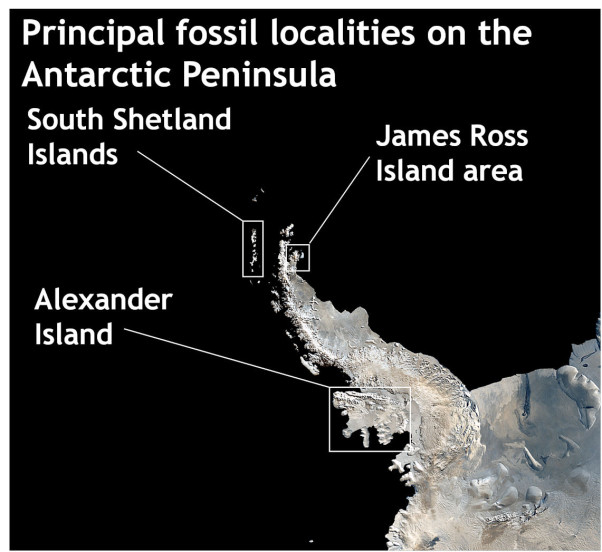Main fossil localities on the Antarctic Peninsula
Fossils collected by BAS come from the Antarctic Peninsula and the islands of the Scotia Arc. Ancient ocean floor began to sink beneath the Pacific margin of the Gondwanan supercontinent during the Jurassic period (200–145 million years ago), forming a chain of volcanic islands which became the Antarctic Peninsula.
Fossils have been preserved in sediments deposited in front of and behind the volcanic island chain, and in layers of ash erupted from the nearby volcanoes. While fossils are found in many areas of the Peninsula, there are a number of notable places which have yielded particularly high amounts:

Alexander Island
The Upper Jurassic to Lower Cretaceous (160–100 million years ago) sediments of the Fossil Bluff Group on Alexander Island contain some of the most abundant and diverse fossil material on the Antarctic Peninsula. The sedimentary rocks comprise fine- to coarse-grained sandy and muddy sediments deposited in front of the volcanic island chain.
The vast majority of the fossils are bivalves, cephalopods and plants, although there are also significant quantities of echinoderms (e.g. sea urchins, starfish), brachiopods (lamp shells) and shrimp.
South Shetland Islands
The volcanic island chain making up the South Shetland Islands was mainly active in the Early Cretaceous (145–100 million years ago). Abundant fossil material is found in sea-bed and volcanically derived sediments of the Byers Peninsula.
The haul here is far less diverse than that found on Alexander Island, being mostly made up of bivalves and plant material.
James Ross Island area
Sediments that were laid down behind the volcanic island chain are exposed in the James Ross Basin. They make up one of the most complete Cretaceous (145–65 million years ago) sedimentary successions in the Southern Hemisphere. The K–T (Cretaceous–Tertiary) boundary — famous for marking the end of reign of the dinosaurs — is well exposed on Seymour Island.
Layers of glacial and interglacial deposits from the Pliocene (5.3–1.8 million years ago) alternate with layers from an extensive volcanic rock sequence — this is known as “interbedding”
Like Alexander Island, the fossil material of the James Ross Island area is dominated by molluscs and plants, but significant collections of fossil shrimps and annelid worm tubes have also been found there. Also, 17 specimens of fossil penguin have been described from Seymour Island, which lies within this area.